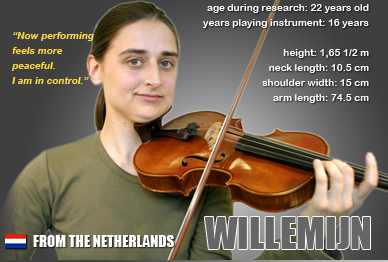3. Making the change
Playing technique
My playing technique has improved a great deal as a result of this research project. I had been struggling for years with many aspects of my technique and I had never been able to find a solution and now all of a sudden I have. The technical improvements happened because there is a lot less tension in my body. This wouldn’t be the case if I hadn’t made all these changes in my equipment and taken the Alexander Technique lessons. If I had only just practiced for one more year, I wouldn’t have made these improvements. Because of the Alexander Technique the tensions in my body were taken away and because of the changes in equipment they don’t return.
After we changed my chin rest and shoulder rest the violin was more loose which forced me to make more contact with it. My left hand playing improved because I had to embrace the neck of the violin more. This helped me to develop a stronger, suppler left hand technique. My intonation is much improved. Earlier I had to struggle to play in tune and often played false. Now it’s the other way around: I almost always play in tune. My playing is also more rhythmical. Before, I had a fast, tense vibrato. Now my vibrato is slower and freer. Position changes are also easier.
My bowing technique is also better. I can make more sound; I have a larger tone. I can now reach the tip of the bow easily. Even my pizzicato is easier.
Changing the equipment
Before the research, I had tried a couple of shoulder rests and I had also changed my chin rest to one that can be put more to the middle of the violin. This was because I found out that I couldn’t reach the tip of the bow and I thought this would help. But in hindsight it wasn’t the ultimate solution, since I still couldn’t use the very end of the tip.
Chin rest
During the research project I changed from the low to a higher chin rest positioned in the middle but slightly to the left of centre. We also tilted the chin rest using corks to match my slanted jaw shape. In my final custom made chin rest this tilt was built into the chin rest itself.
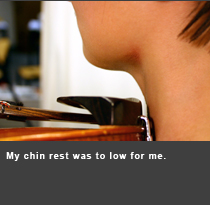
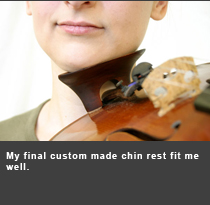
We found out that the most important aspect of the chin rest for me was the shape. The shape of my custom made chin rest matches my narrow jaw, which makes it easy to get a grip on the violin with my head.
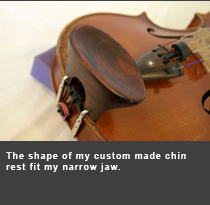
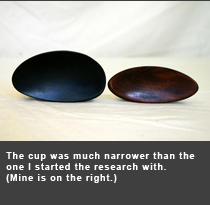
Shoulder rest
The most important thing that I learned for the first time is that the violin has to rest on the collar bone. I then could have more contact with the violin, holding it near my throat between collar bone and jaw, instead of clamping it between my shoulder and jaw. This meant that the violin didn’t slide away from me on the down-shifts as it used to do when I clamped it between the shoulder and jaw only.
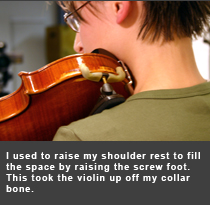
Because of my long neck, I used to raise up my shoulder rest to fill the space. This meant that I had to clamp the violin between shoulder and jaw only, which actually just caused the violin to fall! I think for me there is no good shoulder rest. Most models feel unpleasant and make me uncomfortable in playing. Now I’ve exchanged my shoulder rest for a sponge. It now fits better and doesn’t slip away anymore since I have a chin rest that suits my neck length.
My shoulder rest experiment
During the research, I experimented by constructing my own shoulder rest using a flattened red ball (Eprex)* and a sheet of anti-slip rubber. After cutting the balls in half to make two identical mounded disks, I put one half on my shoulder and the other half near my breast bone. To keep them in place while playing, I sewed one of the balls inside the sheet of anti-slip rubber. The other half ball I attached using pins so that I could try it out in different positions.
I used this “shoulder rest” during the middle of the research, from December to March, to find out where on my body I most needed support for the violin.
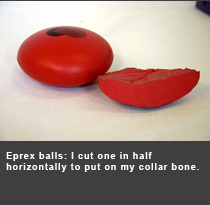
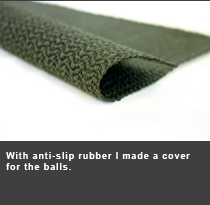
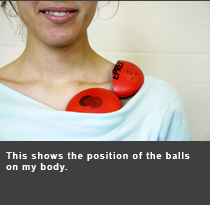
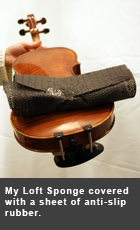
I learned by using the balls that I don’t like it when the shoulder rest is attached to my violin, because then I cannot move my violin. When I was using the balls, the violin was just resting on top of them and moving about freely. I think that the shoulder rest has to fit you and be flexible, so it allows you to move.
Eventually I decided that playing with the balls meant that I had to lift too much with my left hand. Also, in orchestra it was unhandy because my construction would sometimes fall off.
I don’t use a shoulder rest or the balls anymore but the Loft Sponge number 6 wrapped in anti-slip rubber,* which I place on my chest. The sponge is not attached to the violin and I now would never do that. I want to be able to move my violin.
*For information about the equipment mentioned here see “Equipment” section.
During the changes
I felt good during all these changes, especially right after a change in equipment. But after awhile one discovers that it still doesn’t feel right. I sometimes had the feeling that I would never find the right solution. Every time I would make a new change, then after awhile it wouldn’t be good anymore. I think that when you get something new and then learn more, you find out that you want even more. And you then know better what is still missing.
Generally, I quickly became accustomed to the changes. When that wasn’t the case, I knew the adjustment wasn’t right and then I tried something else. The adjustments never made me feel that I didn’t “understand” the violin anymore.
One thing that happened was that I was so busy with the idea that everything had to be changed that I forgot that there was also music, violin playing. I was so focussed on whether or not things went well with my shoulder rest or chin rest, that I was only busy tinkering. My violin teacher said, “I only hear you thinking. I don’t hear you playing music. You are so busy with other things.” He showed me that I could also relax without adjusting the materials. That made me realize that it wasn’t just the materials that were the problem, but also my body.

